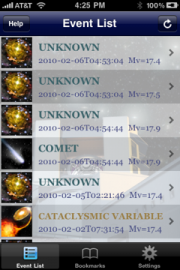Peek Into the Depths of the Universe - With Your iPhone

(PhysOrg.com) -- Transient Events, a new iPhone application for amateur and professional astronomers and anyone interested in the universe, highlights cosmic events such as exploding supernovae, comets traveling through the solar system or blazars -- plasma jets erupting from supermassive black holes.
You're at a party on the patio where everyone is marveling at the clear, star-studded night sky. With a new application for the iPhone or iPod Touch, you can impress them with pictures of a supernova exploding in Orion, a star moving through Cassiopeia, or a cloud of interstellar dust flaring up while being gobbled by a black hole
The application, called Transient Events, uses real-time observational data from the University of Arizona's Catalina Sky Survey to monitor transient objects, or objects that change in brightness or position.
Users select events that interest them, then images are downloaded from the Skyalert database, housed at Caltech. Next, users receive a reference picture and four subsequent images taken over the course of 40 minutes - images that led to the object's discovery.
"With Transient Events, amateur and professional astronomers can monitor what's happening in the night sky," said Stephen Larson, founder of the Catalina Sky Survey. "If they see something of particular interest, they can point their telescopes at the object to take a closer look."
The Catalina Sky Survey, now led by Edward Beshore, employs two telescopes on Mount Lemmon outside of Tucson and one telescope in Australia to scan large swaths of sky. They search mainly for asteroids and comets wandering in proximity of the Earth. The data generated by Beshore's team are then mined by collaborators Andrew Drake and George Djorgovski at Caltech and published on the Skyalert database as they emerge.
Although the night sky appears fairly static to the casual observer - aside from the occasional shooting star - observations made over time reveal a surprisingly dynamic universe: Entire galaxies vary in brightness, comets streak through the solar system and certain stars that circle each other in close proximity occasionally flare up as they rip stellar matter from each other's gravitational grip.
The iPhone application draws from this data, offering a real-time glimpse of the dynamic universe - a feature that sets it apart from other astronomical applications.
"There aren't nearly enough telescopes to catch what is going on in the universe around us, so we're only scratching the surface," said Beshore, also a senior staff scientist at UA's Lunar and Planetary Lab and UA's Steward Observatory.
Transient Events was developed in collaboration with the Large Synoptic Survey Telescope, or LSST, a Tucson-based, non-profit group that's building a telescope to survey vast stretches of the universe. With a mirror that measures 8.4 meters (27.5 feet) in diameter (now under construction at Steward Observatory's Mirror Lab) and the world's largest digital camera that will have more than 3 billion pixels, the instrument will probe deep into space and detect the faintest of objects.
"One of our goals is to explore the transient universe and reveal its dynamic nature," said Suzanne Jacoby, the LSST's manager for public education and outreach. "When the LSST comes online, it will issue tens of thousands of alerts every night for transient objects."
"The Transient Events application is a prototype for the way the LSST is going to work, allowing us to practice now with a manageable number of alerts," she said. "It uses the same principles that will be used by LSST during science operations: Data about changing objects are gathered and provided to others in real-time for follow-up observations and monitoring."
Transient Events uses the operator's location to determine if the object of interest is above the horizon and visable. The user also can receive notifications shortly after an event is discovered.
The developers are hoping to add additional surveys as they come online in the future, for example near-Earth objects such as asteroids and comets traveling nearby.
The application is available to download for free through the iTunes store. To learn more, visit the LSST application Web site.
Please visit this page for PhysOrg.com iPhone Apps
Provided by University of Arizona



















